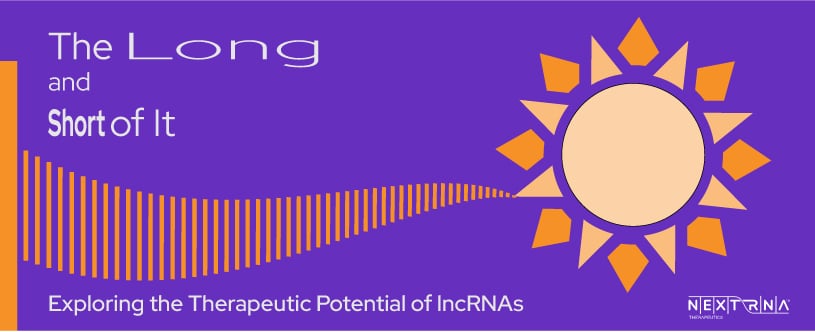At a high level, how would you describe lncRNAs and their function?
What strikes me about lncRNAs, as a class of genes, is their incredible diversity. It’s something I think that we’ve come to appreciate more and more, both in their form and function. People originally thought that lncRNAs had a narrow role in regulation of epigenetics and chromatin. But what we’ve learned and what we’re continuing to learn is that lncRNAs are much more versatile and complicated than that, and they seem to be playing roles in the cell and in physiology that are simply breathtaking in range. They’re playing roles in regulating chromatin, but in all kinds of contexts beyond that, from regulating gene expression at pretty much every step to structurally organizing the nucleus and assembling macromolecular complexes. And we find them throughout the cell, not just in the nucleus, but also in the cytoplasm, involved in metabolism, interacting with the cell membrane, and even being excreted outside the cell. This diversity sets lncRNAs apart from other RNA types, both protein-coding and not, and makes it both intriguing and challenging to study them.
In the past, there has been some skepticism about the functional role of lncRNAs? What would you say to the skeptics?
Well, the first thing I’ll say is that I entirely welcome the skepticism that people have expressed. Good science is built on foundations of skepticism. There is no a priori reason that a given lncRNA should have a function simply because it exists. It’s up to the lncRNA field to design good experiments to distinguish function from the null hypothesis that lncRNAs are non-functional ‘junk.’
Indeed, there are plenty of examples of lncRNAs that have no detectable function, in the sense that our present experimental systems detect no impact of silencing those lncRNAs in the phenotype of a cultured cell or a mouse. While such experiments are the best methods we have, they are not definitive – there is a large gap from observing a happy and healthy laboratory mouse and the reproductive fitness of an animal living in the wild. So, we should interpret all experiments with caveats.
On the other hand, what has been demonstrated beyond doubt is that there is a set of lncRNAs, quite a substantial set, that play very profound roles in human biology and in human disease. So, to me, a more useful question is, “What percent of lncRNAs play meaningful roles in disease and biology?” This is the challenge that I find very exciting.
Does the lncRNA space warrant the same level of excitement as the mRNA space?
The mRNA space – both mRNA-encoding vaccines and mRNA-targeted therapies – are blazing a trail for RNA therapeutics. They’re enabling us to establish core technologies that we need for RNA therapeutics in general – basic manufacturing, targeting, pharmacology, chemistry and so on. These existing, high-profile projects are building up the capacity that I hope the lncRNA field will piggyback on. I see the lncRNA field as the next wave – perhaps higher risk but also high reward.
There are still some very basic challenges to be overcome in the RNA therapeutics world, particularly in terms of delivery, and we’ll have to focus on solving those challenges in the coming years. And then I think you’ll see a flood gate opening – first for mRNA and then, increasingly, lncRNA and other exotic targets coming along. I think people will appreciate the unique benefits of targets that may take them far beyond mRNAs for certain diseases.
What are the unique benefits of lncRNAs as targets?
LncRNAs have characteristics as therapeutic targets that distinguish them very strongly from mRNAs — particularly their specificity. First, we’ve consistently observed that lncRNAs’ expression is more specific across organs and tissues in healthy people. But we see that they’re more specific in other dimensions as well. It seems to be that the downstream gene networks that lncRNAs regulate are more restricted and defined compared to protein-coding genes. They could be more specific to disease and even their activity within cell populations in an organ can be more specific.
One helpful analogy for a diseased cell might be a building, where proteins are like the building’s structure, but the lnRNAs are a more localized regulatory level, like the electronics. If you want to control that cell, you could collapse the walls by inhibiting an important protein, or you could simply flick a switch to turn of the internet supply. The second approach is equally effective, but much less damaging.
And how does this unique specificity translate therapeutically?
It is the specificity of lncRNAs that is generating so much excitement. If we can identify the correct molecular switches, we design a targeted intervention that perturbs or modifies the disease gene network with minimal collateral damage elsewhere in healthy cells. I think our present therapies for many diseases are like taking a hammer to address a problem but, with that brute force, we’re creating all kinds of damage elsewhere. That’s because the targets that we’re focusing on currently are profoundly important signaling molecules or DNA repair processes or epigenetic processes. And you can’t expect to interfere with one of these processes and not cause major damage throughout the body.
This means that the challenge – and opportunity – is to find the correct lncRNAs, the correct switch, that can give us the most power to specifically modulate the behavior of a very defined population of cells. It requires us to search through a huge space – tens of thousands of lncRNAs. And that’s the task at hand in the next few years – getting more and more accurate genomic methods to zoom in on these ideal targets.
In the consensus statement published in Nature Reviews Molecular Cell Biology, you and your co-authors explain that low expression of lncRNAs can be essential for their functional role by ensuring target specificity. Was that a surprising finding? Does lncRNA hold any other surprises?
There are a several aspects of lncRNAs that are surprising and suggest to me that our mechanistic understanding is very incomplete. The first is this expression question. It’s always been the elephant in the room, and it troubles a lot of people. How can something be so important if it is present in such a low number of copies in each cell? We have examples of lncRNAs present in only a handful, or even less than one copy per cell and, yet, when we repress these lncRNAs, the cells respond very strongly. Such observations are highly reproducible, even with different perturbation methods. XIST is a great example. It’s a widely and deeply studied lncRNA – a trailblazer in this space. XIST is only present I think in a few hundred copies per cell, and yet this low expression is still sufficient to silence the enormous X chromosome. There are several potential explanations for this magical activity, particularly in terms of phase separation, but I expect we still have a lot to learn about lncRNAs at the molecular level.
Another surprise is just how many different lncRNAs there are encoded in our genomes. When I started working on this in 2007, we had about 3,000 lncRNAs that my colleague Leonard Lipovich identified in humans, and even at that time we were already excited that there were so many. And now that number has just exploded. Some catalogs have more than 100,000. This is compared to 19,000 protein-coding genes. Now, whether they’re all functional or not, or whether they’re fragments of bigger underlying genes, these are questions we still have to answer. But the sheer volume is something that no one could have anticipated at the start of this journey.
Are there certain therapeutic areas where lncRNAs are more applicable or where we’ve made progress understanding their function?
So far, the most progress has been made in cancer. But, in a nutshell, I think you can find a lncRNA in any disease you care to look at. People may want to explore if they’re involved preferentially in one disease or another. But I think it’s really a question of any change in cellular status, whether it’s a healthy change or a pathological change, we’re probably going to find lncRNAs playing some role lurking there that just hasn’t been unearthed yet.

